 Excess nitrogen in surface waters is not only about fertilizer management, it's also about water management, says Dr. Jerry Hatfield, director of the National Laboratory for Agriculture and the Environment in Ames, IA. Hatfield spoke to a large turnout including many area farmers at the Hawk Creek Watershed Project annual meeting Feb. 28 in Renville. Research accumulating since the 1930s shows that changes in cropping systems away from hay and small grain to intensively-row cropped corn, soybeans, and sugar beets has "changed the whole dynamics" of agriculture and the environment, Hatfield says. (Photo by Tom Cherveny, West Central Tribune-Willmar)
"The loss of nitrogen is basically the loss of money. We need land use changes across the U.S. We need small grains, hay and cover crops." Improving soil organic matter is key. "A lot of things change when we change the soil." It's the foundation of practices that control water in the fields and downstream, he says. "We're losing 1,000 lbs. of carbon per acre per year. That's not sustainable. We need more vegetation and less tillage." Changing as little as 10 percent of the cropped acres in targeted areas would have a significant impact, he says, and simply to reduce the amount of nitrogen fertilizer without better water and crop management is not realistic. All the data and tools can be found online in the Agricultural Conservation Planning Framework. According to the MPCA Nutrient Reduction Strategy, in Minnesota 11.2 million acres would benefit by following U of M recommended fertilizer rates, watch placement and timing of application, and use N inhibitors. The Dept. of Agriculture's proposed nitrogen rule, would regulate fertilizer management for nitrogen in groundwater-sensitive areas.
Back to top
|
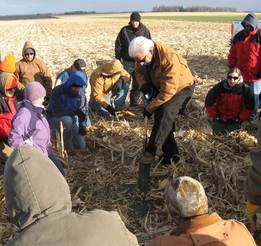 The Rochester Post-Bulletin reports that "The Soil Guy" Ray Archuleta will share his expertise in building healthy soil at several events in southeast Minnesota. Archuleta, who worked for more than 30 years in soil conservation for the USDA’s Natural Resources Conservation Service, was stationed in Idaho in 2005-06 and watching the lakes and rivers fill with sediment. He started asking what was wrong.
The obvious problem Archuleta saw was soil runoff, taking valuable topsoil and nutrients from farmland and washing it toward the lakes and rivers. Soil is alive,” Archuleta said. “It’s an ecosystem.” To make that ecosystem work, he said, farming practices need to emulate nature. Healthy soil takes more work, especially on the front end as a farmer is starting the process, but eventually it leads to a better soil environment for growing, an environment that helps sustain crops through drought. Archuleta spoke March 20 in Kasson and is scheduled for three more dates:
- March 27, 10 a.m.-3 p.m., Lewiston Community Center, 75 Rice St.
- March 28, 10 a.m.-3 p.m., Faribault American Legion, 112 5th St. NE.
- March 28, 6-9 p.m., Riverland Community College, West Campus Garage, 1900 8th Ave. NW, Austin.
RSPV to Land Stewardship Project, 507-523-3366, Ext. 102, or sfillius@landstewardshipproject.org. Fee for each morning event is $20 ($10 for students) and includes a noon meal. There is no fee for the evening event at Riverland Community College in Austin. Photo: Ray Archuleta digs into the soil at a field day several years ago in southwestern Minnesota.
Back to top
|
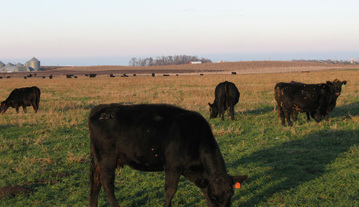 Farm Journal-Ag Professional, 3/13/18:
Despite farmers’ positive perceptions about cover crops and the availability of cost-share programs to incentivize their use, an Iowa State University study shows the return on investment may be the biggest hurdle to overcome for widespread adoption of the practice. “We have a substantial body of research that shows cover crops have positive long-term benefits for water quality, soil health and the environment,” says Alejandro Plastina, assistant professor of economics and extension economist.
But it’s likely that the number of acres planted won’t substantially scale up if the practice doesn’t at least break-even in the short term. "We found that farmers who grazed livestock on cover crops or harvested them for forage or biomass generated sufficient additional revenue or cost savings to result in overall positive returns, in addition to receiving cost-share payments,” Plastina says. “Promoting the use of cover crops for livestock grazing or forage would help a farmer’s bottom line.”
Plastina is developing a website on the economics of cover crops that will include tools for farmers and others to discern potential costs and benefits. The website will include a downloadable spreadsheet with several budget scenarios for cover crops and a simple web-based decision tool to generate estimated net returns to cover crops.
Back to top
|
The Skaug family farm outside of Beltrami has joined the ranks of more than 500 farms achieving the Minnesota Agricultural Water Quality Certification Program. Their farm dates back to 1886, and father and son duo Mike and Ryan farm around 4,200 acres of soybeans, corn, and spring wheat. Mike and Ryan are especially proud of their “split application” of nitrogen and other nutrients. “It’s really difficult to do, but we’re doing it,” Mike said. Article in Crookston Times. Certification numbers as of March 19:
- 541 certified producers
- 335,924 certified acres
- 1,021 new practices implemented
The next MAWQCP Advisory Committee meeting is scheduled for Thursday, March 29. It is open to the public and will be held 10 a.m.-3 p.m. at 1 Hormel Pl, Austin.
Back to top
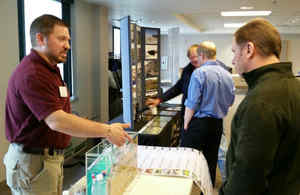 Groundwater quantity and quality issues are surfacing in various arenas around the state. While the Dept. of Agriculture's nitrogen fertilizer rule has been in the spotlight (news release below), the Dept. of Natural Resources is hosting local meetings about groundwater resources, particularly among agricultural producers using more than a million gallons of groundwater each year. Any user at that amount is required to have an appropriation permit and report their usage.
At the first public meeting March 2 in Willmar, Kandiyohi County feedlot operators also learned about the Community-based Aquifer Management Partnership (CAMP) as an option for groundwater users to co-manage shared aquifers. CAMP works best when users know each other and share their water use information, says Tim Gieseke, DNR groundwater specialist. A second Feedlot-CAMP public meeting was held March 15 in Fairmont for Martin County feedlot operators.
In recent years observation wells are showing declines in aquifer levels. Due to geography and geology, groundwater resources are highly variable. In rural areas, livestock operations and irrigation draw the most groundwater. In the DNR Southern Region about 20 percent of the livestock operations use more than 61 percent of the total amount of groundwater used by all livestock operations, according to Anne Nelson, DNR district appropriation hydrologist.
DNR hydrologist Ethan Jenzen encouraged livestock producers to determine if they need a water appropriation permit, and if so apply online. "Water use is part of the economic growth in the county, and we want to make sure water use is sustainable," Jenzen says. Photo: Ethan Jenzen, left, demonstrates the groundwater model at the Kandiyohi County meeting March 2.
Gov. Dayton proposes groundwater protection measure to reduce elevated nitrate levels in drinking water
March 6 news release: Following 17 public meetings engaging more than 1,500 farmers, landowners, and other Minnesotans, Gov. Mark Dayton and Agriculture Commissioner Dave Frederickson proposed a new groundwater protection measure. It would apply to vulnerable areas and areas with high nitrate levels in public drinking waters. It also would create a system of voluntary and mandatory mitigation practices in areas with high nitrate concentrations in the public water supplies. The Dept. of Agriculture expects the rule to be published for formal comment in mid-to-late May with hearings to be held this summer and final adoption in late 2018. Map depicting vulnerable areas (shown in purple and green) where nitrogen fertilizer application would be limited during the fall to protect groundwater from contamination. More information is available on the MDA nitrogen fertilizer rule webpage.
Back to top
|
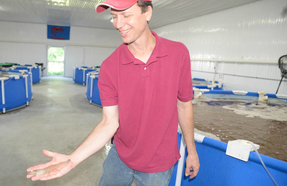
The annual meeting of the Minnkota Agri-Builders and
Equipment Association March 8-9 at Jackpot Junction near Morton featured industry updates and tours of Hanson Silo and Simply Shrimp. The
group brings together regulatory personnel, engineers, building and equipment
suppliers, and university researchers from Minnesota, the Dakotas, Iowa, and
Nebraska to discuss current topics of interest n the animal livestock
world. Updates and application of the propane and fire codes were
presented and discussed.
University research updates focused on effective energy use
in animal holding facilities, effects of leaks in swine barns with incoming air
filters, and removal of hydrogen sulfide from the manure stream to limit
gaseous hydrogen sulfide emissions. The H2S removal research uses
electrically charged plates lowered into the manure stored below the barn which
bind the hydrogen sulfide generating molecules to the plates instead of being
released as gas. The tours visited Hanson Silo Company and Simply Shrimp, both located south of Willmar. Paul Damhof started raising shrimp on the family farm near Blomkest when his parents retired after 50 years in dairy. West Central Tribune photo: Paul Damhof, founder of Simply Shrimp.
Back to top
|
 After several years in the works, the Root River watershed-based plan in southeastern Minnesota is moving forward with a two-year budget and list of projects. Root River One Watershed, One Plan (1W1P), one of five pilot projects launched in 2014 by BWSR, will receive $851,301 for a 2018-2019 budget and work plan addressing groundwater, surface water, social capacity, and administration.
Root River 1W1P’s local government units include Dodge, Fillmore (administrative lead), Mower, Olmsted, Houston and Winona (fiscal agent) counties along with their respective SWCDs. Root River SWCD represents Houston County. Crooked Creek Watershed District in Houston County also is among them.
A four-page summary document about the Root River 1W1P plan and priorities is available to the public, including online on the Mower SWCD homepage at: www.mowerswcd.org. The Root River 1W1P plan and other related documents are available on Fillmore SWCD’s website at: www.fillmoreswcd.org/rootRiverWatershed.html.
BWSR has led the statewide 1W1P program aiming to reduce Minnesota’s more than 200 water-management plans based on political boundaries to less than 100 plans created on watershed boundaries. Watershed-based plans have the potential to allow for streamlined funding and administration to maximize efficiency, minimize redundancy and prevent duplication of efforts both on the local and state levels. - Mower SWCD news release.
Back to top
|
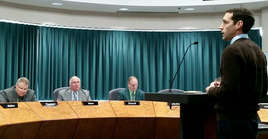
The North Fork Crow River One Watershed, One Plan
is available for public review and comment through March 31. Comments on
the plan should be sent to both: Diane Sander, Watershed Coordinator, Crow
River Organization of Water, 311 Brighton Avenue, Suite C, Buffalo, MN 55313, diane.sander@mn.nacdnet.net;
and Steve Christopher, Board Conservationist, MN Board of Water and Soil
Resources, 520 Lafayette Road North, St. Paul, MN 55155, steve.christopher@state.mn.us. Photo: Steve Christopher reviews the plan at the March 6 Kandiyohi County Board meeting.
The One Watershed, One Plan vision is to align
local water planning on major watershed boundaries with state strategies
towards prioritized, targeted, and measurable implementation plans. It builds
on existing local water management plans and priorities, existing and new
studies and data, Watershed Restoration and Protection Strategies (WRAPS) and
other related plans from state agencies.
Examples of these statewide plans include: Dept. of Agriculture Nitrogen Management Plan, Pollution Control Agency Nutrient Reduction Strategy, Dept. of Natural Resources Prairie Conservation Plan, Dept. of Health Wellhead Protection plans, and
the Metropolitan Council 2040 Water Resources Management
Policy Plan.
Back to top
|

Chryseis Modderman has recently joined the
Department of Soil, Water, and Climate at the University of Minnesota as a new
crops Extension Educator focusing on manure management. She is from
a farm family in west central Minnesota (south of Benson) and has earned a
Bachelor of Science degree in agronomy from Southwest Minnesota State
University, and a Master of Science degree in plant pathology from North Dakota
State University while working as a research specialist. Chryseis
will collaborate with farmers and researchers to identify and address manure
management needs across Minnesota.
The MN Office for Soil Health (at the
University of Minnesota) is seeking to hire an Extension Soil Health Specialist.
On-campus interviews for the top three
candidates will be March 22, March 27, and a date to be determined in early
April. Stakeholders inside and outside the U are
encouraged to
participate in interview seminars and meetings, and to provide feedback about
the candidates. The interview schedules and candidate information are available
on the Soil Health Specialist position web page.
Back to top
|
The Board of
Animal Health, Dept. of Agriculture, University of Minnesota,
and livestock industry groups are collaborating with USDA and other states in planning an aggressive animal disease
response exercise in May. This is the first large-scale exercise
of its kind, incorporating multiple states and the USDA responding
simultaneously to a nationwide event. An avian flu outbreak three years ago resulted in massive losses of poultry in Minnesota, Iowa, and other states.
The exercise will focus on a mock scenario that begins
in another state, eventually causing the disease to spread to multiple states,
including Minnesota. Each state’s participation will vary in complexity. Local
and state participation in the exercise will focus on resource management,
communication, incident command, and response with state and local assets. This exercise will allow Minnesota’s local, state, federal and industry
partners in agriculture and livestock to work through a realistic exercise of a
theoretical outbreak, providing an opportunity to test its emergency
response capabilities. The Pollution Control Agency assists with solid waste and carcass disposal. - BAH Animal Bytes newsletter, March 2018
Back to top
Jacobson earns Environmental Steward Award at Pork Congress
Dr. Larry Jacobson, Professor Emeritus received the 2018 Environmental Steward Award at Minnesota Pork Congress. Jacobson played an important role in helping shape some of today's common industry practices, along with developing the OFFSET Tool, which is still in use today. Read More. Photo: Dr. Larry Jacobson (right) with Randy McMahon, CEO of Balzer, Inc., sponsor of the 2018 Environmental Steward Award.
MASWCD President joins the NACD Soil Health Champions Network
Minnesota Association of Soil and Water Conservation Districts president Kurt Beckstrom has joined the NACD Soil Health Champions Network. The goal of this initiative is to raise awareness and increase the adoption of soil health systems by landowners and managers across the country. NACD will use this initiative to increase the visibility of conservation districts’ leadership in locally led conservation. Beckstrom is a Mille Lacs SWCD supervisor.
Schutz to head CFANS Department of Animal Science
Michael M. Schutz, Ph.D., has been named the new head of the University of Minnesota College of Food, Agricultural and Natural Resources Sciences Department of Animal Science. Schutz, a professor in the Department of Animal Science at Purdue University, is currently the Assistant Director of Extension at Purdue University and oversees Extension Program Leaders for Agriculture and Natural Resources.
Funding sources found for SDSU precision agriculture facility
South Dakota State University’s new precision agriculture facility is one step closer to reality. The Legislature approved the funding for this project, sending the bill to Governor Dennis Daugaard. Nearly $17 million for the facility will come from private donations. SDSU will invest $11 million and the state will provide more than $18 million. The state funding will come from a one-time $2 million appropriation and an increase in fertilizer fees. - Red River Farm Network
Minnesota Association of County Feedlot
Officers conference March 27-29
The annual conference of the Minnesota Association of County
Feedlot Officers is scheduled for March 27-29 at the Marriott Courtyard Hotel
in St. Cloud. The event provides training credits for county feedlot staff, and
a local feedlot tour. Program topics include: Program updates, biosecurity,
manure and nutrient management, process waste water, and construction
stormwater. A registration form and full agenda reside on the MACFO webpage. Under the delegated program, 50
counties administer the state's 7020 feedlot rule with the exception of large feedlots requiring
state or federal operating permits.
Videos feature six communities and their water systems
The Minnesota Dept. of Health created a series of videos about six community water systems and how they provide their
communities with safe, reliable drinking water. The city of Worthington and partners created the Worthington
Wells Wildlife Management Area to protect the city’s drinking water wells from
contamination and provide pheasant habitat. pioneering solution to protect the
city’s drinking water wells from contamination and provide pheasant habitat. The
Minnesota Department of Health has provided assistance with Worthington’s
source water protection efforts and water shortage challenges. Other videos feature New Brighton, St. Martin, Fairmont, Oakdale, and St. Cloud.
Back to top
Federal partnership kicks off next phase of water quality challenge
EPA news release, 3/1/18
USDA offers renewal options for expiring conservation stewardship contracts
USDA news release, 3/7/18
Renville County's increased buffer offer boosts interest
West Central Tribune, 3/8/18
Soil health gains traction in farm country: Reduced tillage, cover crops offer benefits
West Central Tribune, 2/24/18
Precipitation changes threaten grazing lands, UMN study says
Minnesota Daily, 3/4/18
Buffer-related lawsuit fails in Minnesota
AgWeek, 3/16/18
Farm & rural helpline answers the call for mental health
News release, 10/6/17
Back to top
March 27-29: Minnesota Association of County Feedlot Officers, Marriott Courtyard, St. Cloud.
April 12-14: State of the Water Conference, Freshwater Society, Breezy Point Resort, Brainerd.
Back to top
The
MPCA Feedlot Update welcomes news from partners about, projects, people, and
upcoming events. Email submissions to forrest.peterson@state.mn.us.
Past issues of Feedlot Update are available on the feedlot program publications webpage.
|